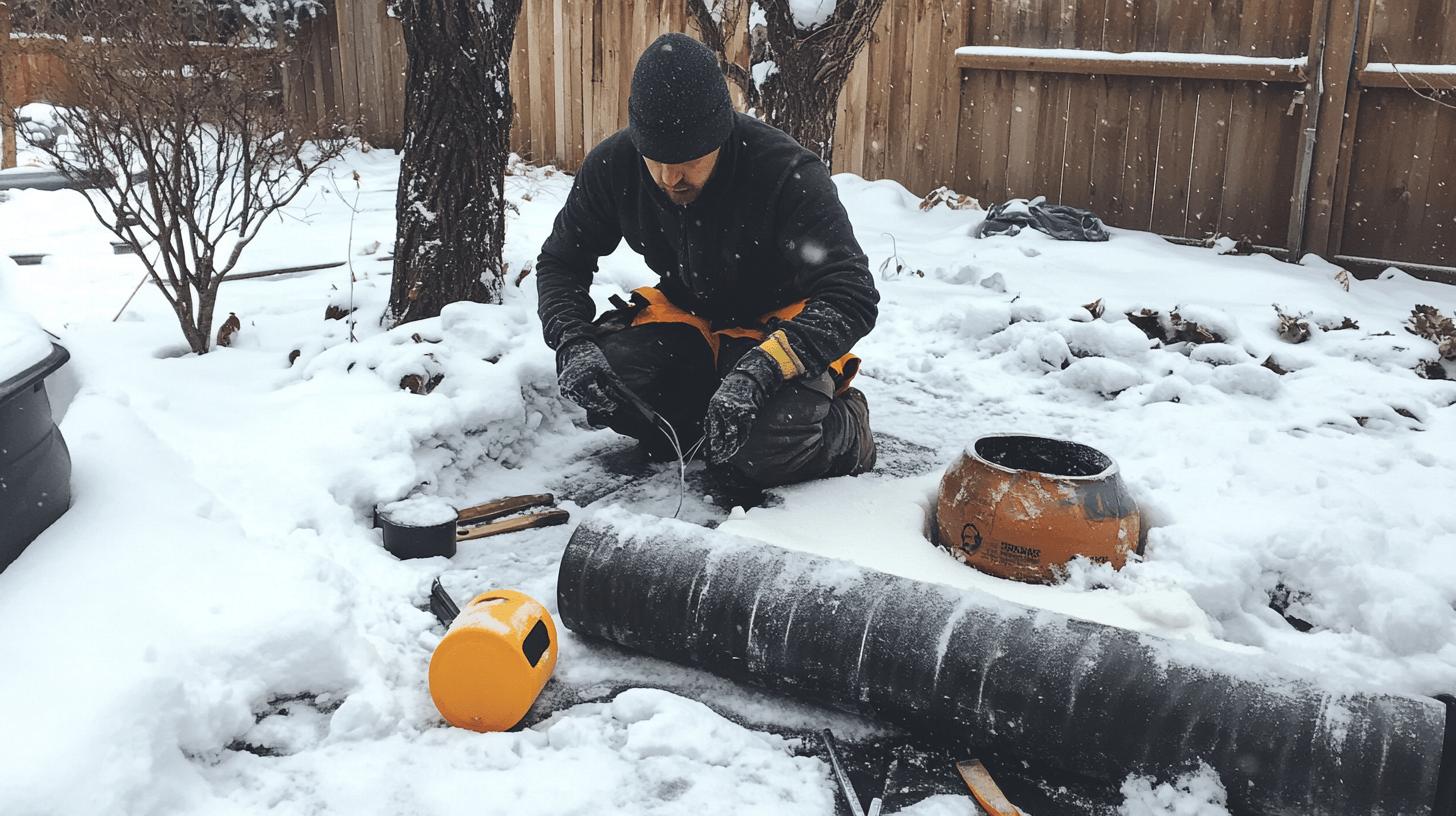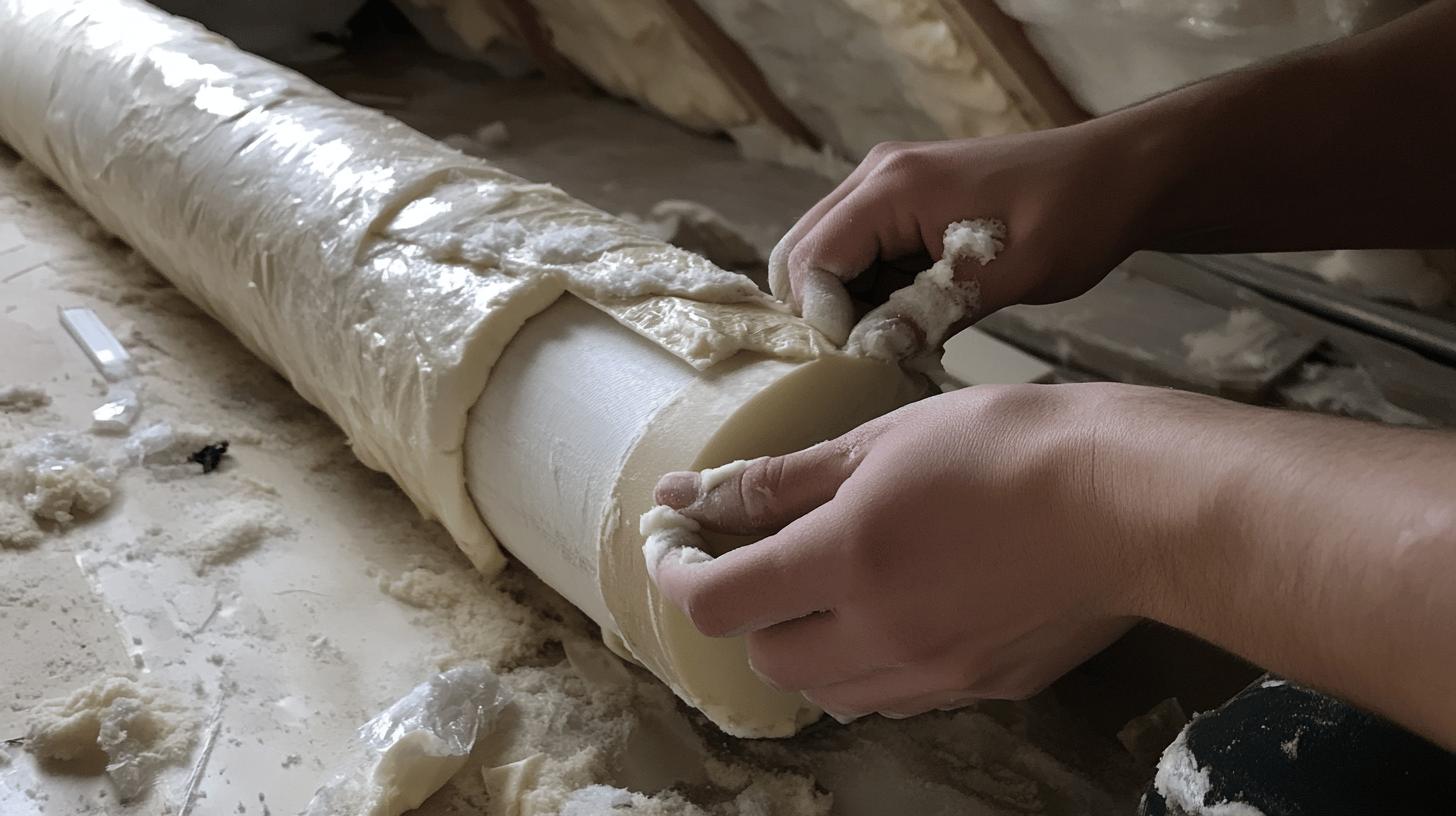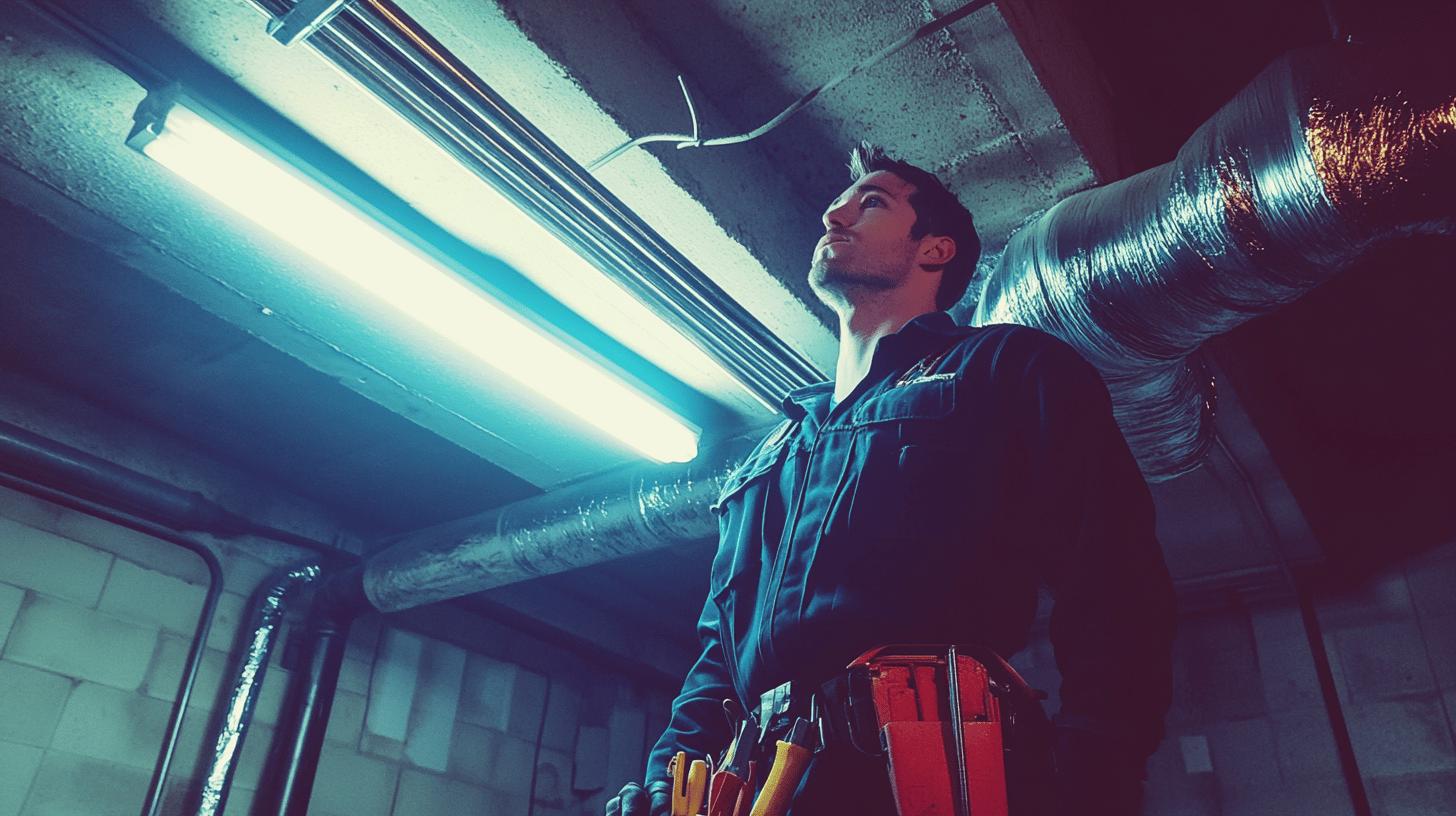TL;DR:
- Insulating pipes prevents freezing, condensation, and heat loss.
- Popular insulation materials: Foam pipe insulation, Heat tape, Fiberglass pipe wrap, Rubber foam, Polyethylene foam.
- Prevent pipe freezing by shutting off outdoor faucets, insulating fixtures, using heat tape, maintaining indoor temp above 60°F, and letting faucets drip.
- Best winter pipe covers: Foam pipe wrap (moderate thermal resistance) and Fiberglass insulation (high thermal resistance).
- Use non-toxic materials like Rubber foam, Polyethylene foam, and Mineral wool for safety and environmental benefits.
- Call a plumber for complex systems or persistent plumbing issues, and schedule regular inspections to maintain insulation effectiveness.
Have you thought about how much insulating your pipes can help your home? Covering your pipes isn’t just a small chore—it’s super important for keeping your plumbing system working well and lasting longer. In this guide, we’ll look at the best materials for pipe insulation so you can make smart choices. Insulating your pipes can protect your home from freezing, stop heat loss, and cut down on annoying plumbing noises. Whether you want to save energy or make your plumbing last, knowing your options is essential. Let’s dive into how insulating your pipes can benefit you!
What Do You Cover Your Pipes With: An Essential Guide
Insulating your pipes helps prevent freezing, condensation, and heat loss, which can lead to major damage and costly repairs. Good insulation is essential for home maintenance. By keeping your pipes at a stable temperature, you can avoid bursts during cold weather and reduce annoying plumbing noises. Plus, it saves energy by keeping hot water hot and cold water cold. Choosing the right material and making sure it’s installed correctly is super important, especially with materials like fiberglass, where wearing safety gear is necessary to protect yourself from particles.
Popular pipe insulation materials include:
- Foam pipe insulation
- Heat tape
- Fiberglass pipe wrap
- Rubber foam
- Polyethylene foam
Each insulation material has its own perks, making them suitable for different environments and pipe types. Foam pipe insulation is great for straight sections since it’s easy to install. Heat tape acts like a blanket, keeping pipes warm in super cold weather. Fiberglass wrap is ideal for high-heat areas, while rubber foam works well around bends and curves. Polyethylene foam is versatile and offers solid thermal resistance. Insulating your pipes with these materials not only reduces heat loss and lowers energy bills but also helps your plumbing system last longer.
How to Prevent Pipe Freezing with Proper Insulation

Keeping your pipes from freezing is essential to avoid costly damage and repairs. When temperatures drop, unprotected pipes can freeze and burst, leading to significant water damage. Insulating your pipes and taking preventative steps protect your plumbing system from harsh cold, ensuring your home stays comfortable and safe.
Here are five effective steps to insulate and protect your pipes from freezing:
-
Shut off and drain outdoor faucets. This stops any remaining water in pipes from freezing and expanding, which could cause cracks or bursts.
-
Insulate exposed fixtures with foam or tape. Use foam pipe insulation or pipe wrap tape to cover vulnerable areas, providing a barrier against the cold.
-
Apply heat tape to vulnerable areas. This electrically powered tape acts like a heating pad, keeping pipes warm even in freezing conditions.
-
Keep the indoor temperature above 60°F. This ensures the ambient temperature around pipes stays warm enough to prevent freezing.
-
Let faucets drip during extreme cold. A small trickle of water reduces pressure and helps prevent freezing inside the pipes.
Keeping a steady indoor temperature is key to preventing pipes from freezing. Even when you’re not home, setting your thermostat above 60°F helps warm areas like basements and attics where pipes are vulnerable. Allowing faucets to drip can also prevent freezing and reduce pressure buildup. By using these tips, you can protect your plumbing system from the harsh winter cold.
Best Pipe Covers for Winter and Their Application
For winter pipe covers, foam pipe wrap and fiberglass insulation are excellent options. Foam pipe wrap is popular because it’s easy to install, making it perfect for long, straight runs. It offers decent thermal resistance, making it suitable for general use in homes. On the other hand, fiberglass insulation is best for high-heat areas since it has a higher R-value, providing superior protection for pipes in critical spots. To get the most out of both materials, make sure to secure them with tape to prevent cold air from getting in.
| Material | Suitable Use | R-Value |
|---|---|---|
| Foam Pipe Wrap | Straight pipe runs | Moderate |
| Fiberglass Insulation | High heat areas | High |
| Rubber Foam | Bends and curves | Moderate |
To install insulation effectively, begin by cleaning the pipes to remove any dust or residue. Measure the pipes accurately to choose the right insulation size. Wrap the foam snugly around the pipes and secure it with adhesive or duct tape. For fiberglass insulation, overlap the material slightly and secure it tightly with tape. Just be careful not to make it too tight, as that can reduce its insulation effectiveness. Proper installation boosts performance and helps extend the life of your pipes during harsh winter conditions.
Cost-Effective Insulation Solutions for Your Pipes

DIY pipe insulation is a practical and budget-friendly way to shield your plumbing from extreme temperatures. Insulating your pipes helps prevent damage, reduces repair costs, and boosts your home’s energy efficiency. This means less heat loss in hot water pipes and prevents cold water pipes from sweating, which can lead to condensation. Plus, the savings on your utility bills can really add up, making DIY insulation a smart investment for homeowners.
When looking for cost-effective materials, foam sticks are a popular choice because they’re easy to install and come in various sizes to fit different pipe diameters. These sticks are typically made from polyethylene or rubber, both of which provide good thermal resistance. Fiberglass pipe wrap is another affordable option, especially for pipes in high-heat areas. Both materials also help reduce noise, creating a quieter plumbing system.
To get the most out of your insulation, accurate measurement and installation are key. Start by measuring the length and diameter of the pipes you want to insulate. Make sure the insulation fits snugly without compressing the material, as this can decrease its effectiveness. Secure the insulation with adhesive or duct tape, paying special attention to joints and bends that are prone to heat loss. By following these steps, you’ll effectively insulate your pipes, improve energy efficiency, and protect them from temperature extremes.
Safety and Environmental Considerations for Pipe Insulation
When insulating pipes, safety is the top priority. If you’re using materials like fiberglass, make sure to wear safety glasses, work gloves, and a dust mask to avoid irritation. Good ventilation is essential during installation to prevent inhaling harmful fibers. Always use the right tools and follow the manufacturer’s guidelines to minimize risks. If you’re ever unsure about the process, it’s best to consult a professional plumber to ensure everything is done safely and effectively.
Non-toxic insulation materials include:
- Rubber foam
- Polyethylene foam
- Mineral wool
Choosing eco-friendly insulation options not only helps the environment but can also improve indoor air quality. Rubber and polyethylene foam are great choices because they provide excellent insulation without releasing harmful chemicals. Mineral wool, made from natural or recycled materials, is both sustainable and effective at providing thermal resistance. By selecting materials with a lower environmental impact, you can contribute to a healthier planet while keeping your home energy-efficient. Whenever possible, opt for recyclable or biodegradable materials to further reduce your footprint.
Professional Insight: When to Call a Plumber for Pipe Insulation

Knowing when to call a professional plumber for insulation can save you time and prevent costly mistakes. If you’re dealing with complex systems, like HVAC units or commercial plumbing, it’s best to leave it to the experts. These intricate setups can run into problems if they aren’t properly insulated. A professional plumber has the experience and tools needed for efficient installation. If you notice ongoing issues like leaks or temperature fluctuations despite your DIY efforts, it’s time to reach out for professional help. Acting quickly can prevent further damage and protect your investment.
Regular maintenance and inspections are key to keeping your pipe insulation in good shape. A professional plumber can conduct thorough checks to identify any wear and tear that might affect insulation performance. They’ll look for gaps, compressions, or any areas where the material is deteriorating. By scheduling regular inspections, you can catch problems early and extend the lifespan of your insulation. This proactive approach ensures your plumbing system remains energy-efficient and reduces the risk of failures or costly repairs down the line.
Final Words
Understanding what to use for covering your pipes is essential for protecting your home from potential issues like freezing and heat loss. In this guide, we’ve looked at different materials and methods, such as foam pipe insulation and heat tape, that help keep water at the right temperature and improve energy efficiency. Properly insulating your pipes ensures they perform well and stay safe, which can save you from expensive repairs down the line.
By selecting the right insulation materials and using preventative techniques, you can confidently protect your plumbing systems. Embrace these budget-friendly strategies to maintain your home’s plumbing integrity and enjoy peace of mind.
FAQ
What do you cover your pipes with in the winter?
Cover your pipes with foam pipe insulation, heat tape, fiberglass wrap, rubber foam, or polyethylene foam to prevent freezing and condensation.
How do you cover your pipes outside?
To cover outdoor pipes, use materials like foam insulation or heat tape, which can withstand external conditions and provide adequate protection.
What is the best material to cover pipes?
The best materials for covering pipes include foam pipe wrap for straight runs and fiberglass insulation for high-heat areas, offering good thermal resistance.
How to keep outdoor water pipes from freezing with DIY methods?
Keep outdoor pipes from freezing by shutting off water supply, wrapping them with foam or heat tape, and allowing water to drip during extreme cold.
How to keep pipes from freezing without heat?
To protect pipes without heat, insulate them properly, shut off exterior faucets, and consider using temporary measures like duct tape and rags.
What is the minimum temperature to keep pipes from freezing?
Maintain an indoor temperature above 60°F to help prevent pipe freezing.
When should you worry about pipes freezing?
Pipes are at risk of freezing when temperatures drop below 32°F, particularly in uninsulated or exposed areas.
How to wrap outside pipes for winter?
Wrap outside pipes using foam insulation or heat tape, ensuring they are secured well to withstand winter conditions.
How can you protect pipes from freezing outside?
Protect outdoor pipes by insulating with foam or heat tape, shutting off water supply, and allowing faucets to drip in extreme temperatures.
At what temperature will pipes freeze in a house?
Pipes inside a house may freeze when the indoor temperature drops below 32°F, especially in unheated or poorly insulated areas.

